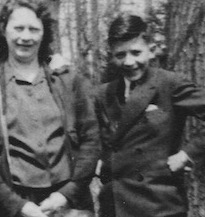


Bill Muster (1926-1989); photo circa 1950 "Man of Our Time" - International Teleproduction Society, 1988 | |

Bill with his mother, 1934. 

Nuremberg Palace of Justice. 




|
My dad grew up in Chicago during the Great Depression. His father died before he was born and his mother died when he was nine. After that he went to an orphanage for a little while, then grew up in a series of foster homes. The people at one of the foster homes encouraged him to read and go to college. He once told me he loved to read memoirs and reading saved him. As a teenager he got a camera and used it to make money doing freelance photography. By age seventeen he worked for Acme Newsphotos and was a copy boy for the Chicago Tribune. In 1944 when he was eighteen he joined the Army. From November 1945 to December 1946, he served as a sergeant and aircrew member in the U.S. Army Air Force in the U.S. and Germany. In Ansbach, Germany, he was publicist, section head, and photo chief of the base photo lab. He also served as photographer for the Ansbach Record, a weekly paper for American GIs in Germany. Ansbach is just outside of Nuremberg, and he photographed the Nuremberg trials for the military. After the Army, he worked his way through college at the University of Illinois with the GI Bill, freelance writing and photography, part-time at ACME Newspictures, and summer jobs as a staff photographer at Alexander & Associates of Chicago, a creative service agency. He photographed the Chicago Railroad Fair in 1948 and 1949, and the Chicago Fair of 1950. In 1948 his boss asked him to accompany Walt Disney to the Fair because Disney wanted to build a them park and was doing research at the time. At the University of Illinois Muster was photo chief and associate editor of the University of Illinois Illio yearbook and The Daily Illini, the independent student newspaper at the University of Illinois since 1871. He was a member of Sigma Delta Chi journalism fraternity. He married my mother in 1950, the same year he completed his Bachelor of Science in journalism at the University of Illinois. For the first three years after college he returned to ACME Newspictures as a writer, editor, and photographer. Soon after that, Acme Newsphotos transferred them to Minneapolis, where my father became the bureau chief and my mother was a staff photographer. In 1953 they decided to quit their jobs and move someplace warmer. My father studied all the demographic information available and decided Hollywood was the best place to live. For six years he was a merchandising manager at Capitol Records. I was born in 1956 and my brother was born in 1958. For two years after leaving Capitol, Dad worked at Ampex with marketing associate Piet Goedewaagen to popularize magnetic tape. They used his Hollywood connections to secure contracts with record companies to market their vinyl LPs as reel-to-reel tapes. In the process, Ampex sold lots of tape players. From 1961 to the end of his life, Bill Muster ran a series of businesses from his building at 6900 Santa Monica Boulevard - Historic Route 66. The building had bow truss roofs, and is an example of Depression Era Art Deco, which was less decorative to reflect the hard economic times. Business run under that roof, along with senior business partner Richard Simonton included: the Los Angeles and Orange County music by Muzak franchise, California Communications, sound and lighting equipment rental company, and later studio; Pacific Network, Inc., selling intercom and telephone equipment to businesses; the Delta Queen Steamboat Company, and the editorial offices of his travel book series for the Rand McNally, World Traveler's Almanac. It was remodeled as a post-production studio in the 1980s and 1990s. One of the greatest honors he received in his lifetime was the Society for American Travel Writers' Marco Polo Award in 1988. They also named their photo contest after him for his effort in developing the show. It is now known as the SATW Bill Muster Photo Awards. Bill Muster lived the last seventeen years of his life in his Skylark Lane home, in the hills above Sunset Strip. He died at home surrounded by friends and family on January 3, 1989. The International Teleproduction Society named him "Man of our Time" in 1988, just weeks before his passing. His legacy is the Bill Muster Foundation, which supports photo journalism and travel photography, along with organizations that work for better communication and social justice. |
|
Links Nuremberg Trials | Capitol Records | Art Deco Building | Delta Queen Steamboat | World Travelers Almanac, Rand McNally | Bill Muster Photo Awards | Bill Muster Foundation | Timeline | Bill Muster genealogy | Bill Muster at Wikipedia. | Additional information and links Love and many thanks to my father, who has been gone thirty-three years today. - Nori, January 3, 2022 | |
